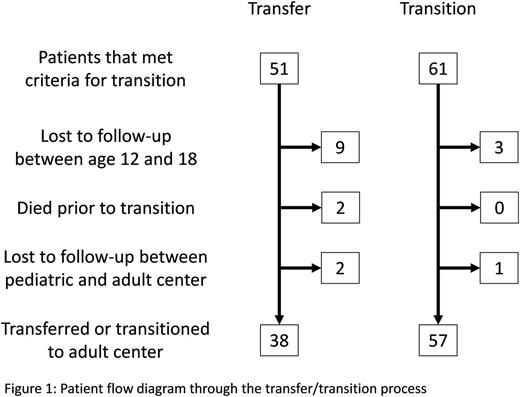Abstract
Introduction: Adolescents and young adults (AYA) with sickle cell disease (SCD) and thalassemia transitioning from pediatric to adult health care experience a lack of engagement with adult care providers, are at high risk of loss to follow-up, emergence of psychosocial issues, morbidity and mortality. The shift from a pediatric to an adult setting can be challenging for AYA who are coping with multiple life transitions and are expected to acquire the necessary skills to manage their own care.
Hypothesis: implementation of a comprehensive structured transition program with dedicated transition navigator (TN) in a pediatric and adult hemoglobinopathy comprehensive care center will reduce loss to follow-up and hospitalization, improve adherence to medication and attendance to appointments compared to an unstructured transfer from pediatric to adult program.
Methods: A structured comprehensive transition program with a dedicated TN, based on a quality improvement framework with an iterative design to refine the intervention over time, was developed and deployed across a pediatric and adult hemoglobinopathy comprehensive care center (Hospital for Sick Children (HSC) and Toronto General Hospital (TGH) respectively) starting August 1, 2014. Prior to this, patients at age 18 were transferred without preparation. With the TN model, adolescents, from age 12 were followed at each visit by the TN and up to one year after transitioning. Prior to transition to the adult center, adolescents were seen jointly by pediatric and adult care providers and TN in a transition clinic. Patients were assessed for transition readiness and provided with tailored education at each appointment. This observational study compared all AYA with SCD or thalassemia who turned 18 years between August 1, 2013 and August 1, 2015. Patients in the cohort prior to the comprehensive transition program were compared to patients who transitioned through the formal program. Data from one year prior to last appointment at HSC and one year after the first appointment at TGH were collected. The effects of covariates on imaging/clinic/transfusion/subspecialist appointment attendance, medication adherence and hospitalizations were analyzed by multivariable regression.
Results: 112 patients met the criteria for transfer/transition, of which 51 transferred prior to August 1, 2014 and 61 transitioned through the comprehensive transition program. No significant differences were observed in baseline demographics including age at transfer/transition, phenotype, distance from the center, medications, parental/guardian appointment attendance, immigration status, family structure, first language spoken or documented cognitive impairment. The youngest patient to undergo transition in the observation period was 16.6 years. The transition process significantly reduced the proportion of patients lost to follow-up from 29% (11/38) to 7% (4/57) (P = 0.0335, Figure 1). In patients who were on hydroxyurea or iron chelation, significant increase in the proportion of patients who maintained or improved their medication adherence to 4 or more days a week was observed in the transition cohort (P = 0.047, LR 4.668) and the presence of the transition program was independently associated with the improvement. A trend towards improvement or maintenance of ≥ 90% attendance to appointments was observed (P = 0.096, OR 2.254). Variations in appointment attendance can be explained by patient's age, distance from the comprehensive hemoglobinopathy center, and English as patient's first language. No independent predictor was found in frequency of hospitalization. No new overt strokes or deaths occurred in the year after moving to the adult center.
Conclusions: Comprehensive structured transition program with dedicated transition navigator significantly reduced the number of AYA lost to follow-up, and significantly improved and maintained fair to good medication adherence. Further analysis of economic benefit and patient satisfaction will be conducted. A clustered randomized-controlled trial will be forthcoming to determine the effectiveness of this transition model of care on AYA patients with sickle cell disease on patient-important outcomes.
Allemang:Novartis: Other: Funding for the transition navigator program; ApoPharma: Other: Funding for the transition navigator program; Sickkids Foundation: Other: Funding for the transition navigator program. Kuo:Apotex: Other: Unrestricted education grant; Novartis: Consultancy, Honoraria, Membership on an entity's Board of Directors or advisory committees; Agios Pharmaceuticals: Consultancy, Membership on an entity's Board of Directors or advisory committees; Alexion Pharmaceuticals, Inc: Consultancy, Honoraria, Membership on an entity's Board of Directors or advisory committees, Research Funding.
Author notes
Asterisk with author names denotes non-ASH members.


This feature is available to Subscribers Only
Sign In or Create an Account Close Modal